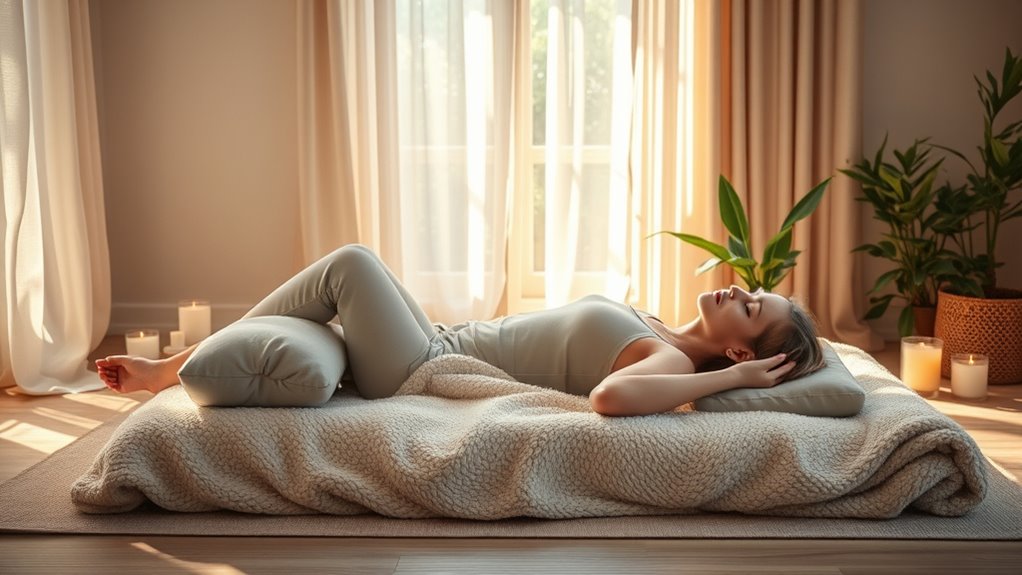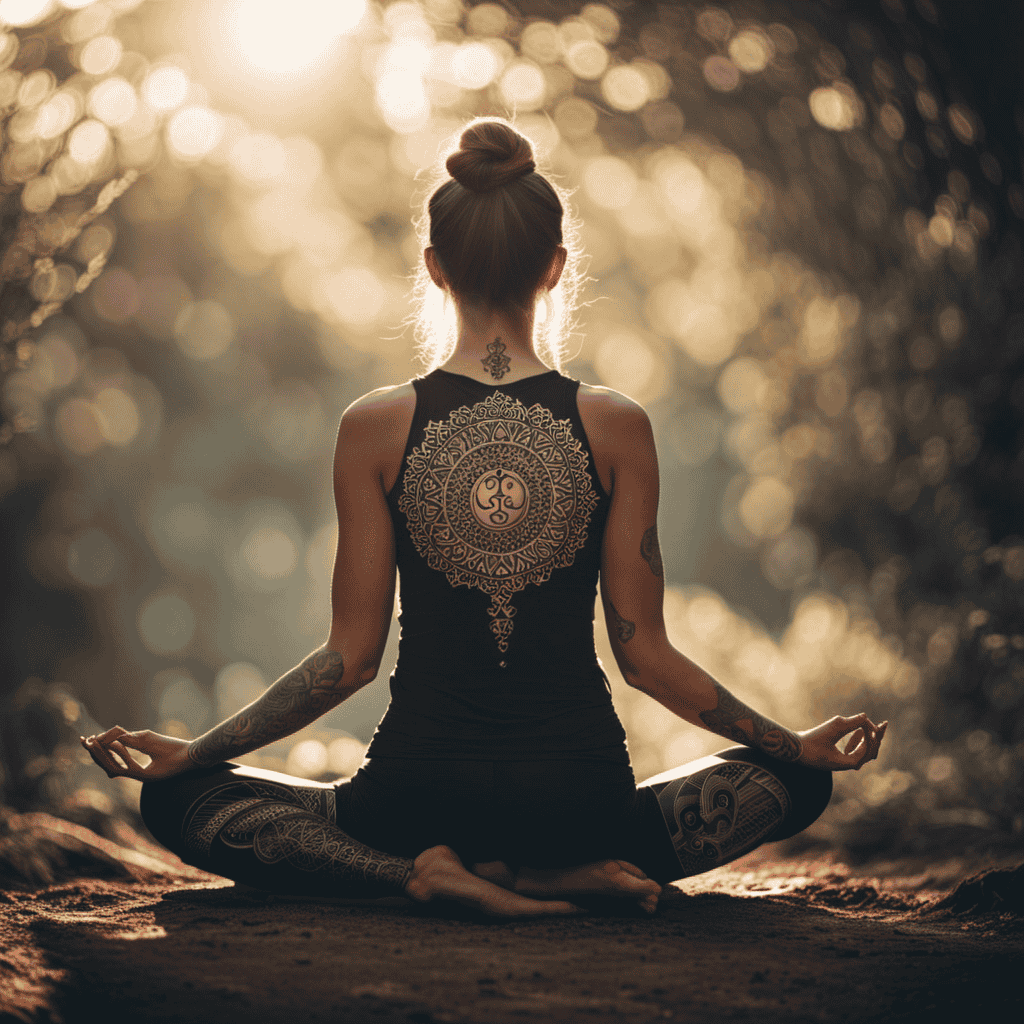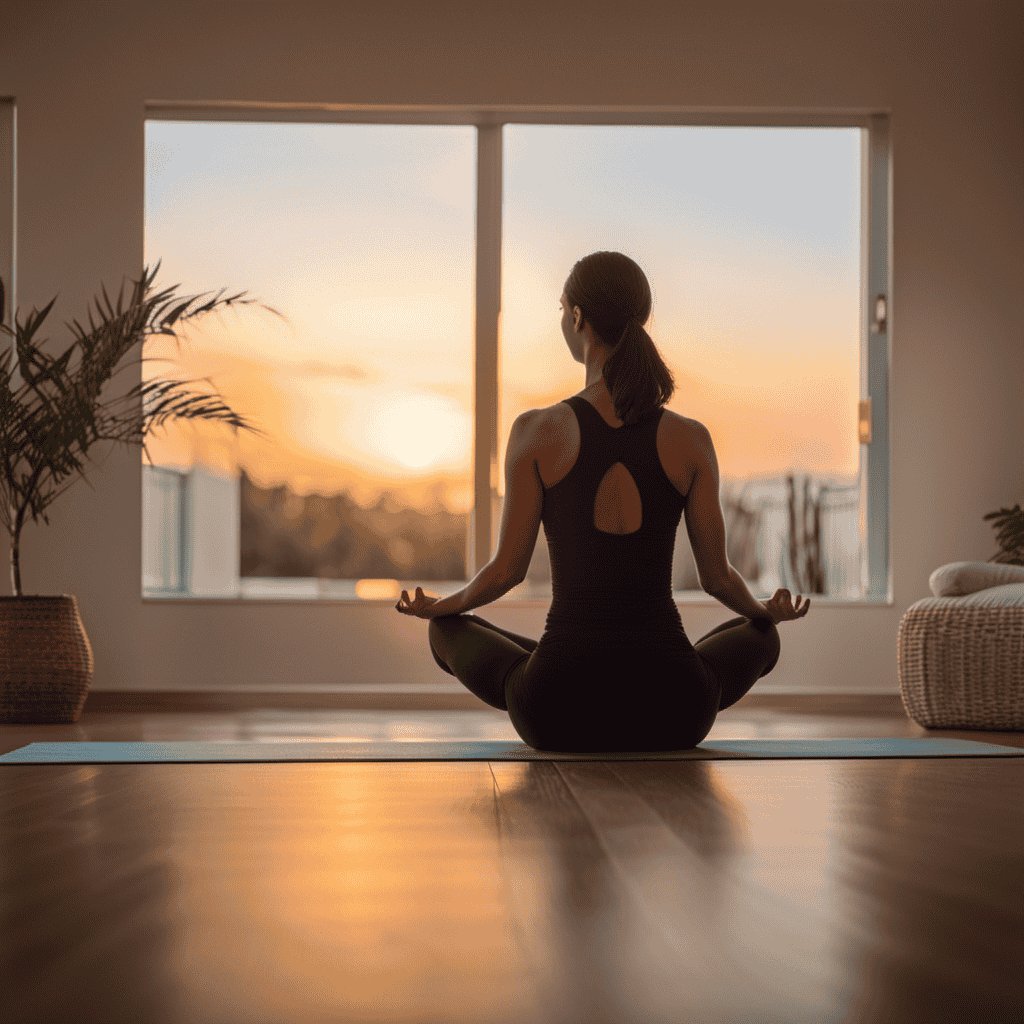Restorative yoga encourages deep relaxation by guiding you into gentle, supported poses that easily surrender gravity’s pull. Combining slow, mindful breathing techniques and meditation, it calms your nervous system and promotes inner tranquility. Using props for comfort, you hold poses for several minutes, fostering sustained calm and stress relief. This gentle approach nurtures your body and mind while encouraging self-awareness. Keep exploring how these practices can transform your relaxation routine and bring lasting peace.
Key Takeaways
- Restorative yoga uses props and gentle poses to promote deep physical and mental relaxation.
- Holding poses for several minutes enhances relaxation through gravity and sustained support.
- Combining mindful breathing techniques like diaphragmatic and box breathing calms the nervous system.
- Incorporating mindfulness meditation helps anchor awareness and quiet racing thoughts.
- Regular practice fosters resilience, emotional balance, and integrates relaxation techniques into daily life.

Have you ever felt overwhelmed or exhausted and wondered how to find true relaxation? If so, restorative yoga might be exactly what you need. Unlike more active forms of exercise, restorative yoga emphasizes deep relaxation through gentle poses and mindful practices. To truly benefit, you’ll want to incorporate breathing techniques and mindfulness meditation into your routine. These tools help calm your nervous system, reduce stress, and promote a sense of inner peace.
Start by settling into a comfortable pose, often supported by props like bolsters, blankets, or blocks. As you breathe, focus on slow, deliberate inhales and exhales. Breathing techniques such as diaphragmatic breathing or box breathing can deepen your relaxation. When you breathe deeply, you signal your body that it’s safe to unwind, lowering cortisol levels and easing tension. As you hold each pose, turn your attention inward, observing sensations without judgment. This is where mindfulness meditation plays a crucial role. By anchoring your awareness to your breath or bodily sensations, you create a meditative state that quiets racing thoughts and fosters present-moment awareness.
Begin in a comfortable pose, focusing on deep, mindful breathing to promote relaxation and inner calm.
During your practice, you’ll want to stay mindful of each inhale and exhale, noticing how your body responds. This focused attention not only enhances relaxation but also cultivates a sense of acceptance and compassion towards yourself. Restorative yoga encourages you to surrender into each pose, allowing gravity and support from props to do the work. While you may hold a pose for several minutes, your mind remains engaged with your breathing and sensations, preventing your thoughts from wandering. Incorporating mindfulness techniques can further deepen your relaxation and mental clarity.
Consistency is key. As you regularly incorporate breathing techniques and mindfulness meditation into your restorative yoga sessions, you’ll notice a gradual shift in your ability to relax deeply. Over time, these practices become a natural part of your routine, helping you manage stress more effectively and bring calm into your everyday life. Restorative yoga isn’t about pushing your limits but about nurturing your body and mind through gentle, intentional practices that promote profound rest.
In essence, combining breathing techniques and mindfulness meditation with restorative yoga creates a powerful pathway to deep relaxation. You learn to slow down, breathe intentionally, and remain present, giving your nervous system the break it craves. With patience and consistency, you’ll discover a greater sense of tranquility and resilience, making it easier to face life’s challenges with calm and clarity.
Frequently Asked Questions
Can Restorative Yoga Help Reduce Chronic Pain?
Yes, restorative yoga can help reduce chronic pain by strengthening your mind-body connection. Through gentle poses and deep relaxation, you activate your body’s natural pain management techniques, easing tension and inflammation. Regular practice encourages mindfulness, allowing you to better understand and manage pain triggers. This holistic approach not only alleviates discomfort but also promotes emotional well-being, making restorative yoga a valuable tool in your pain management routine.
What Equipment Is Necessary for Restorative Yoga Sessions?
You only need a few props for restorative yoga, and most of them are simple. Around 80% of practitioners find bolsters, blankets, and blocks help deepen relaxation. Props needed include a bolster or pillow, blankets for cushioning, and yoga blocks for support. Wear comfortable clothing that allows free movement and doesn’t restrict your body. With these essentials, you can create a calming space to fully unwind and relax.
How Often Should I Practice Restorative Yoga for Best Results?
You should practice restorative yoga at least 2-3 times a week for the best results. Practice consistency to build relaxation and improve flexibility, but always listen to your body and avoid pushing too hard. Regular sessions help you deepen your relaxation and reduce stress over time. Remember, gentle patience and regular practice will maximize the benefits, so find a routine that fits your schedule and stay committed.
Is Restorative Yoga Suitable for Beginners With Limited Flexibility?
A journey of a thousand miles begins with a single step, and restorative yoga is perfect for beginners with limited flexibility. It’s highly suitable because you can use modifications for flexibility and choose beginner-friendly poses. These gentle stretches help you ease into yoga comfortably, ensuring you don’t feel overwhelmed. With patience and consistent practice, you’ll gradually improve your flexibility and enjoy the deep relaxation restorative yoga offers.
Are There Any Health Conditions That Contraindicate Restorative Yoga?
You should be cautious if you have medical restrictions or specific health conditions, as restorative yoga might not be suitable. Always consult your healthcare provider before starting, especially if you’re pregnant or have chronic issues like hypertension or heart disease. Some poses may need modification, and certain conditions could worsen with practice. Listening to your body and seeking professional advice guarantees safe and beneficial yoga sessions tailored to your health needs.
Conclusion
Practicing restorative yoga can truly transform your sense of calm, making stress feel like a distant memory. As you surrender into each pose, you’ll discover a profound peace so deep it’s almost overwhelming. This gentle practice isn’t just relaxation; it’s a portal to reclaim your inner serenity, more powerful than any storm. Embrace these moments of stillness and let restorative yoga guide you to a level of tranquility that might just change your life forever.









